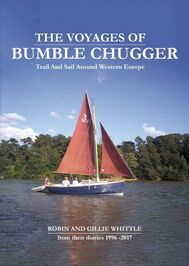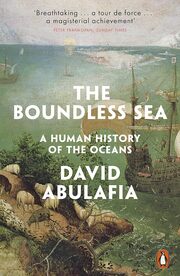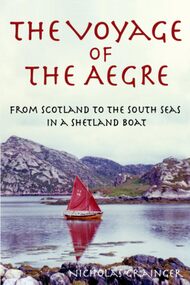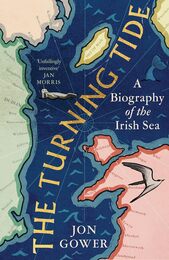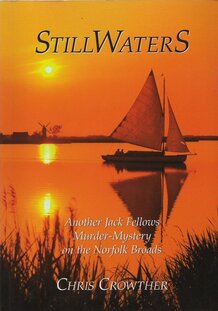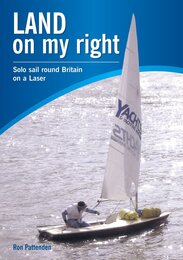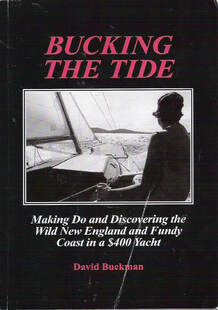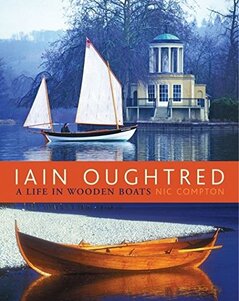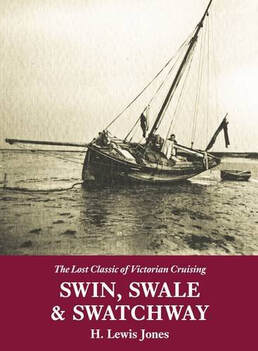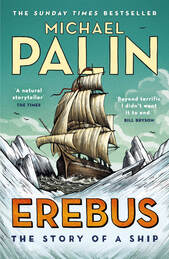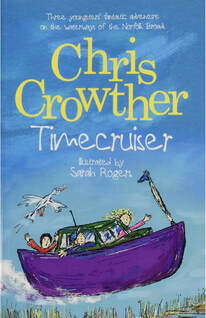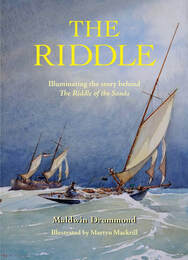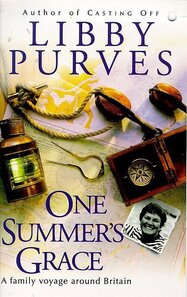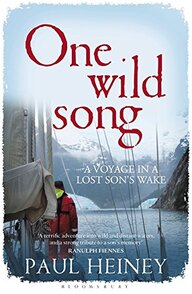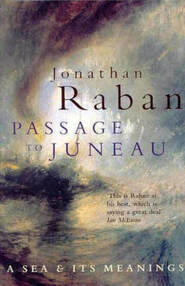The DCA Journal Dinghy Cruising regularly features excellent book reviews, written by Members or the Editor himself. Here are a selection for you to enjoy:
|
The Voyages of Bumble Chugger by Robin and Gillie Whittle
Review by Chris Forrest in DC 256 When I saw the Voyages of Bumble Chugger and noticed in the blurb that Gillie and Robin had sold their 505 dinghy and bought this Cornish Shrimper 19-footer for their 60th, trailer-sailed her for 25 years and this self-published book was a compilation of their greatest hits, I sent off for a copy because the coincidence with Anna and I buying our 19-foot Bay Raider Expedition for our 60th birthdays was too good to be true. This A4-sized book thunked onto the doorstep, the thickness of 4 Journals. In all I counted 42 trip reports. Most pages are illustrated with 3 or 4 photographs, maps and drawings. It’s exactly what I’d hoped for; a bona fide Inspiration Manual! Read on... |
|
The Boundless Sea A Human History of the Oceans by David Abulafia
Review by Bill Jones in DC 255 As dinghy cruisers we inhabit a parallel world to that of cruising yachts and larger vessels. Our boats are small, and our sailing waters correspondingly modest in scale. We celebrate those passages and ports of call which are denied to deep keel vessels, such as Newtown Harbour (Isle of Wight), Chichester Harbour, the upper reaches of rivers, or lakes. All the intricacies and satisfactions of passage planning and landfalls can be realised in our modest voyages. Of course there are notable exceptions: the epic voyages of Frank Dye’s Wayfarer in the North Sea and America, or of Howard Rice’s Scamp in the southern ocean, but the above description generally holds good. David Abulafia’s The Boundless Sea takes an entirely different perspective. Read on... |
|
The Voyage of the Aegre by Nicholas Grainger
Review by Matthew Sullivan in DC 259 This book is an account of an adventure in a 21 ft Shetland boat, sailing all the way from Scotland to the South Seas. Nicholas Grainger distinguishes himself from other writers in this genre by writing 50 years after the voyage to reflect on what happened, how it happened, and the psychological impact of the experience on him and his young wife, Julie. It is far too common in nautical literature for authors to feel that their readers will be satisfied with reading what is effectively a logbook rather than an autobiographical experience. Grainger does not make this mistake, providing us instead with an exciting series of sailing yarns whilst also giving us insights into the psyche of a young couple trying to forge their way in the world together while living alone with the sea. Read on... |
|
The Turning Tide A Biography of the Irish Sea by Jon Gower
Review by Keith Muscott in DC 258 When I was an active member of ORCA years ago I would board the ferry to Norway with other enthusiasts and do my shift on the bridge armed with a pair of bins to scan the horizon for signs of life. Despite watchers on other trips logging odd sightings of cetaceans, we saw zilch – except for a different kind of marine life on the cruise liners berthed by us in Bergen. Cut to my home in Anglesey. In their season, I can see Risso's dolphins from the top of nearby cliffs where there are steep drop-offs with plentiful food in the depths; or harbour porpoises up close and personal from local beaches. Just a couple of examples of locally abundant sealife. Welcome to the Irish Sea. Read on... |
|
Still Waters by DCA Member, Chris Crowther Review by Keith Muscott in DC 208
These still waters certainly run deep. When Sally Beckett returns from a three-month backpacking break taken to forget a failed love affair and an unsatisfying job in the City, she finds that a grandfather she never knew she had has died in suspicious circumstances and bequeathed her a Broads boatyard and a rambling old house. Grandfather Charles was found by Broads Navigation Ranger and ex-Met detective Jack Fellows, floating face down in a reed bed after he had fallen from his beautiful old yacht Ace of Hearts. Fallen or pushed? The police prefer the second possibility and Sally is their main suspect. Sally is propelled into a murky Broads waterworld which you, dear reader, will not have met on holiday there. It includes a satisfyingly long list of more or less suspicious characters... Read on... |
|
Land on my right by Ron Pattenden
Review by Ted Jones, followed by a letter from the author, in DC 208 Here’s a book we can all read and enjoy since it’s about a solo dinghy sail round Britain ... wait for it ................. in a Laser dinghy ! At first I thought it must be a well-supported venture with rescue boats bobbing around, engines throbbing, and crews at the ready to pull the author from the drink and help him return his capsized boat to the upright. But I was completely wrong. It was very much an individual effort to raise money for the Prostate Cancer Charity. Was he brave, lucky, foolhardy or just plain stupid? Everyone will have their own take on this but reserve your judgment until you’ve read the book. Read on... |
|
Bucking the Tide by David Buckman Review by Keith Muscott in DC 208
On Kimball Island, Penobscot Bay, the backfiring engine of a lobster fisherman’s 1950-something truck drew the author into a closer inspection: no doors, no exhaust muffler, no fenders, one headlight, big holes in the floor – it was used for short trips between home and the dockside and was totally outside the law, like most of the island’s vehicles. ‘You’d be surprised by how many car parts you can do without,’ the driver called out cheerily, as he drove away in a cloud of smoke. This anecdote could stand as a motif for the author’s six-season cruise up the Atlantic coast of North America, from Narragansett Bay to the Canadian border and the notorious Bay of Fundy, location of the world’s biggest tides. The book’s subtitle includes the words, ‘making do in a $400 yacht’ and David Buckman eschews inessential equipment as much as he does redundant yachty attitudes. Read on... |
|
Iain Oughtred: A Life in Wooden Boats by Nic Compton
Review by Nick Watt in DC 209 This book examines an unusual individual. Oughtred was one of a small group of designers and boatbuilders who pioneered the clinker approach to plywood boatbuilding during the 1970s and 80s. His designs borrow heavily from traditional craft, which he studied closely. Compton makes clear, however, that Oughtred's expertise has not been attained without significant personal sacrifice. He is portrayed as an uncomfortable loner who has often felt at odds with many elements of his upbringing and his native Australia. He has a wonderful designer's eye and a clear sense of purpose, couple with an almost inhuman amount of determination and focus. He has lived most of his life in close to abject poverty, still eschews computer-assisted design and is perhaps more of an artist than a naval architect in his outlook. Read on... |
|
Swin, Swale & Swatchway The Lost Classic of Victorian Cruising by H. Lewis Jones
Review by Keith Muscott in DC 225 THE LAST DECADE OF THE 19TH CENTURY saw many young middle class British men – and eventually women – joining the myriad of professional sailors, fishermen and longshoremen on the waters around our coasts, often to their irritation, or to be exploited by them financially, or to be genuinely helped by them: frequently a mixture of all these, as the events in this book sometimes show. In the 1890s tales of amateur sailing enjoyed a surge of popularity which was to return to Britain at regular intervals over the years, as in the 1960s when sailing came within the grasp of all and even crossing the oceans under sail or oar became a common dream. H. Lewis Jones and his sailing companion C.B. Lockwood, with Dr C.E. Shelly on occasion, were typical of those 19th century enthusiasts – young high-spirited graduates, who in their case were medical men. Read on... |
|
Erebus: The Story of a Ship by Michael Palin Review by Len Wingfield in DC 240 IN RECENT YEARS we have been satiated with stories of Franklin’s attempt to find the Northwest Passage, TV pictures of mummified crewmen and so on. However Palin, past President of the Royal Geographical Society, has written a book that revived my keen interest. It covers the story of the Erebus and her sister ship Terror, from their building to the discovery of their wrecks and the latest evidence suggesting reasons for the disastrous ending of Franklin’s expedition. Read on... |
|
Timecruiser by Chris Crowther
Review by Keith Muscott in DC 240 ‘Taleweaver’ is Chris Crowther, just as ‘Tusitala’, the teller of tales, was Robert Louis Stevenson. Unlike RLS, Chris is an exhelicopter and aircraft pilot, DCA member, passenger boat skipper, and an ardent lover of the Norfolk Broads, which leads him to write mystery fiction that is rooted therein. Timecruiser is aimed at a younger readership than his other books. The back cover reads: ‘A run-down boatyard, a strange boat and three youngsters left alone on board with a warning not to touch anything. But Max had to show off... “Leave it alone, Max!” warned Jenny. But it was too late...’ (I like him already.) The infernal machine suddenly fires up with ‘an ear-splitting whine and a teeth-chattering vibration, while a blue mist seemed to envelope the whole boat...’ And we’re off. Read on... |
|
The Riddle: Illuminating the Story Behind the Riddle of the Sands
by Maldwyn Drummond Review by Keith Muscott in DC 233 Shortly after the war, in 1951, Drummond found himself in his 5-tonner Runa VII tied up to a salvage crane in Boulogne Harbour and reading The Riddle of the Sands for the first time. When he finished the novel he suggested to his crew that they might sail along the coast too and investigate – cautiously – the islands and harbours of the German Friesian estuaries. He didn't have to ask twice. So began years of obsessive research into Victorian Corinthian yachting, pre-WWI politics and all things 'Riddle'. The result is this book. Read on... |
|
One Summer's Grace by Libby Purves;
One Wild Song and The Last Man Across the Atlantic by Paul Heiney Review by Simon Rippon in DC 237 One Summer’s Grace, The Last Man Across the Atlantic and One Wild Song are three very different books in style and content, but I have chosen to review them as a trilogy because of their common background, rooted as they are in family, seamanship and voyaging. All subjects close to the hearts of DCA members. Read on... |
|
Passage to Juneau: A Sea and Its Meaning by Jonathan Raban
Review by Len Wingfield in DC 233 This is an account of a difficult and hazardous single-handed voyage by a famous travel writer who took to sailing rather late in life. Raban’s 1,000 mile Seattle to Juneau cruise partly followed the famous exploratory voyage of Captain Vancouver, and his account digresses into the history of that voyage and the life of the coastal Indians and many related environmental and political issues. It is also partly autobiographical. Raban’s boat was a fine seaworthy 35-foot wooden ketch which he had used as a floating cottage as well as a serious seagoing cruiser. It carried a massive library of sailing and general literature, but Raban says very little about the boat itself. Read on... |
The friendly club with a sense of adventure. For all sailors who use boats for more than just racing.
|
© 2010-2024 DCA. All Rights Reserved. |
|

